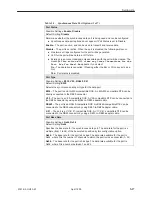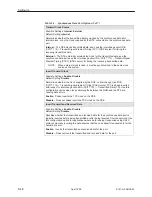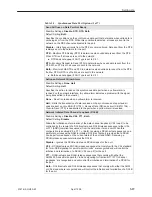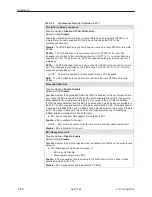
Setting Up
5-31
9161-A2-GH30-40
April 1999
Table 5-6.
FXS Voice – Slot ss Port p Options (3 of 4)
Wink Duration (10 ms)
Possible Settings: 1 – 99
Default Setting: 20
Determines the duration of the wink signal generated towards the network when an
off-hook signal for the CO is detected and after the wink delay has elapsed in
increments of 10 milliseconds.
Wink Duration only appears if:
– Port Status is set to Enable.
– Operating Mode is set to FXSDN/WINK.
10 to 990 ms – The valid range is from 10 to 990 ms, in 10 ms increments. The settings
are numbers between 1 and 99, representing such increments. The default is 20, for a
wink duration of 200 ms.
Rx Gain (dB)
Possible Settings: –10.00, –9.5, –9.0, –8.5, ..., 0.0, +0.5, +1.0, +1.5, +2.0
Default Setting: 0.0
Determines the receive path analog signal amplification, or gain, on the FXS voice port
in decibels. This is the gain (increased signal level) or attenuation (decreased signal
level) applied to the signal.
Rx Gain (dB) only appears if Port Status is set to Enable.
–10.00 to +2.0 – Increases or decreases the signal level. The more positive the
number, the greater the signal level.
Tx Attenuation (dB)
Possible Settings: –10.00, –9.5, –9.0, –8.5, ..., 0.0, ..., +4.0, +4.5, +5.0
Default Setting: 0.0
Determines the amount of attenuation, in dB, that the FXS voice port applies to the
analog signal presented by the user’s analog equipment. Positive TX Attenuation
settings reduce the level of the encoded analog signals sent towards the telephone
network and negative settings introduce gain. When connecting permissive mode
modems and fax machines, a setting of +3 dB should result in a compliant, encoded
analog of less than –12 dBm. The proper setting of this strap is crucial to ensuring
compliance with Part 68, FCC Rules and Industry Canada’s CS-03 Specification.
Tx Attenuation (dB) only appears if Port Status is set to Enable.
–10.00 to +5.0 – Increases or decreases the signal level. The more negative the
number, the greater the signal level (opposite of Rx Gain settings).
Ring-Back Tone
Possible Settings: Enable, Disable
Default Setting: Disable
Allows generation of an audible tone toward the network in response to an incoming call
request, normally referred to as a ring-back. This feature is invoked only when the
central office (CO) does not provide it, as with a Class 4 ESS switch. This tone indicates
to the calling party that the called line has been reached and ringing has started. Use
the ring-back tone when you have a PLAR application.
Ring-Back Tone only appears if Port Status is set to Enable.
Enable – Generates a ring-back tone toward the network in response to an incoming
call request.
Disable – Does not generate a ring-back tone toward the network in response to an
incoming call request.
Summary of Contents for 9161 Single T1
Page 1: ...MODEL 916x 926x T1 ACCESS MUX TECHNICAL REFERENCE Document No 9161 A2 GH30 40 April 1999...
Page 34: ...Management and Control 2 6 9161 A2 GH30 40 April 1999 This page intentionally left blank...
Page 54: ...User Interface 4 10 9161 A2 GH30 40 April 1999 This page intentionally left blank...
Page 92: ...Setting Up 5 38 9161 A2 GH30 40 April 1999 Example Channel Allocation...
Page 142: ...Security 6 10 9161 A2 GH30 40 April 1999 This page intentionally left blank...
Page 252: ...IP Addressing B 8 9161 A2 GH30 40 April 1999 This page intentionally left blank...
















































